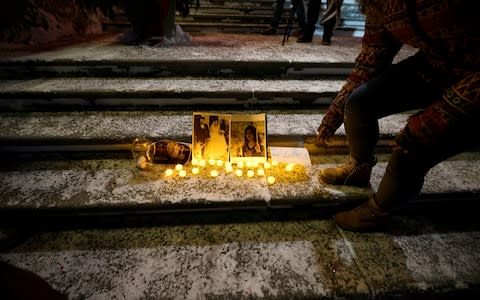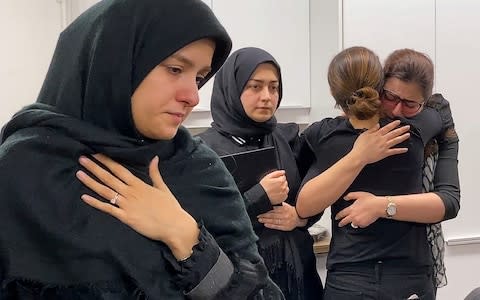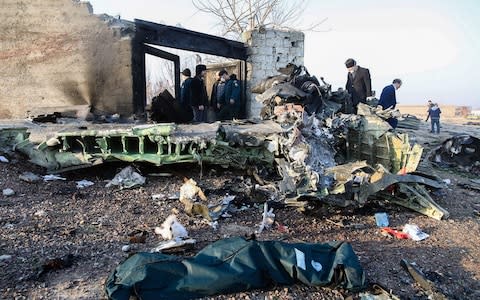Boris Johnson says Iran shot down Ukrainian plane, possibly by accident

Boris Johnson has said that Iran shot down the Ukrainian passenger plane in Tehran after Western intelligence agencies concluded that the downing of the jet was most likely an accident.
US satellites reportedly picked up two surface-to-air missiles being launched shortly before the accident and US officials suspect there are missile fragments near the crash site where all 176 passenger died.
Mr Johnson said: “There is now a body of information that the flight was shot down by an Iranian Surface to Air Missile. This may well have been unintentional."
His comments came shortly after Justin Trudeau, the prime minister of Canada, which had 63 nationals on board, said "multiple intelligence sources" pointed to a missile strike that appeared to be accidental.
British and Canadian officials said they believed the US assessment was credible, with one UK source telling The Daily Telegraph “specific details” had been shared with Britain backing up the claim.
However, the head of Iran's Civil Aviation Organisation pushed back, calling the allegation “illogical” and asking why the plane had turned back towards the airport if it had been hit by a missile.
Ukrainian International Airlines flight 752 took off just hours after Iran had fired rockets at US soldiers stationed in Iraq, leading to speculation the accident could have come from the “fog of war”.
America’s belief that the alleged missile launch was a mistake is underscored by the fact that 82 Iranian citizens were killed in the crash, alongside 63 Canadians and 11 Ukrainians.
Four Britons were also among the dead, according to Mr Johnson – including engineer Sam Zokaei, from Surrey, Saeed Tahmasebi Khademasadi, from west London, and Mohammad Reza Kadkhoda Zadeh, from near Brighton.
Mr Johnson confirmed four Britons died in the plane crash, up from the earlier reports of three. The fourth dead British citizen was not identified but it emerged last night that Arad Zarei, 17, who went to school in the UK was among the dead .
Britain on Friday said it was advising against all travel to Iran.
"Given the body of information that UIA Flight 752 was shot down by an Iranian surface-to-air missile, and the heightened tensions, we are now advising British nationals not to travel to Iran," Foreign Secretary Dominic Raab said.
"We also recommend against taking a flight to, from and within Iran," he added, in a statement from the Foreign Office.
"We urgently need a full and transparent investigation to establish what caused the crash."
A video purporting to show the moment the Ukrainian plane was struck was published by numerous US media outlets on Thursday including The New York Times and CNN.

The footage appears to show an object moving quickly through the dark night sky followed an explosion. The Daily Telegraph could not verify the accuracy of the video.
Newsweek, CBS and CNN first reported the US conclusion on Thursday afternoon, all referencing US officials saying they believed it was likely anti-aircraft missiles downed the plane by accident.
Mr Trump declined to be explicit about how he thought the plane had crashed or who was behind it when asked during a White House event, but said: “I have my suspicions”.
"Some people say it was mechanical. I personally don't think that's even a question,” Mr Trump said, adding: "Something very terrible happened.”
The Democrat-controlled US House of Representatives last night passed a war powers resolution demanding that Mr Trump not engage in military action against Iran unless authorised by Congress. It ignited a debate about whether the president has the power to declare war. The measure will now go to the Republican-controlled Senate, where its fate is uncertain.
The Ukrainian plane left Imam Khomeini International Airport in Tehran at 6.10am local time on Wednesday bound for the Ukrainian capital Kyiv.
Hours earlier, amid a tense stand-off between Tehran and Washington, Iran had launched rockets at US soldiers in two Iraqi bases in retaliation for the killing of its commander Qassim Soleimani.
The decision to fly despite the launch of a military attack hours earlier has been called into question, with some asking why all passenger planes were not barred from passing through the airspace.
Multiple US media outlets reported that satellites, radar and electronic data collected routinely by US military and intelligence lay behind America’s assessment that Iran was to blame.
US officials said data showed Iranian radar had been tracking the plane before the missiles were fired, according to Reuters. The plane was reportedly airborne for just two minutes before an explosion.
CNN noted punctures on the aircraft’s fuselage found among the wreckage, possibly indicating an explosion outside the aircraft had taken place.

Witnesses said the plane appeared to be on fire before it crashed. According to an Iranian initial assessment, it turned back towards the airport from before going down.
A UK source told this newspaper: “The picture that seems to be emerging among all Western officials is that the plane has been accidentally downed by an anti-aircraft missile. We are not disagreeing with that."
But Ali Abedzadeh, the head of Iran's of Civil Aviation Organisation, questioned the claims, saying: "Scientifically, it is impossible that a missile hit the Ukrainian plane, and such rumours are illogical."
An Iranian government spokesman called the suggestion Iran shot down the aircraft "psychological warfare".
The country's foreign ministry said it invited Canada to take part in the investigation and submit any information it may have to its investigative committee.
Boeing and the Federal Aviation Administration declined to comment on Thursday, as did the Pentagon. Ukrainian officials had no immediate comment.
The tragedy has echoes of Malaysian airlines flight MH17, which was shot down by Russians as it flew over eastern Ukraine in 2014 amid an emerging civil war in the area.

Iranian officials said the Ukrainian plane’s black box, which tracks flight data, has been recovered. CNN reported it would be handed over to the Ukrainians on Friday.
However, it is unclear if the black box alone will provide conclusive evidence about the cause of the crash, with some experts saying the wreckage itself could be more significant.
Oleksei Danilov, the secretary of Ukraine’s national security council, said a 45-person strong Ukrainian team had reached the crash site just outside of Tehran and would search for missing fragments.
Mr Danilov said: "A strike by a missile, possibly a Tor missile system, is among the main (theories), as information has surfaced on the internet about elements of a missile being found near the site of the crash.”
He appeared to be referring to unverified photographs posted by a number of Iranian Twitter users of what appeared to be a missile nose cone.
Mr Danilov said the team was in “effective diplomatic talks" with Iran on the joint investigation and had “every reason to hope for full cooperation on all questions including our team’s access to the black boxes.”
Volodymur Zelenskiy, the president of Ukraine, said Iran’s president Hassan Rouhani had promised him the Ukrainian team would have full access to the crash site during a telephone call on Thursday afternoon.
Mr Johnson spoke to Mr Zelenskiy on Thursday and called for a “full credible and transparent investigation”.
"The reports we have seen are very concerning and we are urgently looking into them," a spokesman for the Prime Minister’s office said.

